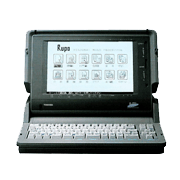Toshiba began selling the Rupo JW95HV personal word processor in 1991. The JW95HV’s primary claim to fame was its wide 160-dot print head, which could print three lines simultaneously and reach printing speeds as fast as 230 characters per second. This was a huge leap in printing speed over Toshiba’s previous Rupo models, which printed at 70 characters per second. Toshiba even advertised the JW95HV as the “three-line revolution.”
- The Rupo JW95HV also had the following features.
-
- 1. Neuro-learning function
- This function adapted to the user’s conversion preferences to select among homophones more accurately by analyzing the relationships between word pairs and learning these combinations as conversion candidates.
- 2. Able to combine three fonts — Mincho, Gothic, and Mouhitsu — in one document
- 3. Icon-driven menus
| External dimensions [mm] and weight | 365 x 395 x 103 (w x d x h), 6.5 kg |
|---|---|
| Power supply | 100 VAC, 50 / 60 Hz, 0.8 A |
| Display device | Backlit white LCD screen 40 Japanese characters x 20 lines (80 Japanese characters x 38 lines in condensed mode) |
| Printer | Thermal printer (56 x 56 dots, 10 P) 230 characters per second (160-dot head) Outline fonts (Mincho, Gothic, Sei Kaisho, Mouhitsu) |
| Entry modes | Whole paragraph conversion (up to 60 characters) |
| Conversion | Conversion dictionary: 150,000 words (basic dictionary: 78,000 words) AI conversion: 400,000 candidate words |
| User-defined dictionary | 2,000 words |
| Learning functions | Neuro-learning, recently selected priority, long-average frequency learning |
| Document length | Long document: 48,000 characters, normal document: 16,000 characters |
| Optional functions | MS-DOS text conversion, personal database |


